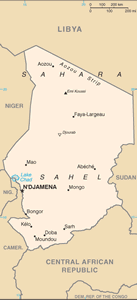The Geography of Chad
The Geography of Chad
Chadian Geography
Location: Central Africa, south of Libya
Geographic coordinates: 15 00 N, 19 00 E
Map references: Africa
Area: total: 1.284 million sq km land: 1,259,200 sq km water: 24,800 sq km
Area - comparative: slightly more than three times the size of California
Land boundaries: total: 5,968 km border countries: Cameroon 1,094 km, Central African Republic 1,197 km, Libya 1,055 km, Niger 1,175 km, Nigeria 87 km, Sudan 1,360 km
Coastline: 0 km (landlocked)
Maritime claims: none (landlocked)
Climate: tropical in south, desert in north
Terrain: broad, arid plains in center, desert in north, mountains in northwest, lowlands in south
Elevation extremes: lowest point: Djourab Depression 160 m highest point: Emi Koussi 3,415 m
Natural resources: petroleum, uranium, natron, kaolin, fish (Lake Chad), gold, limestone, sand and gravel, salt
Land use: arable land: 2.8% permanent crops: 0.02% other: 97.18% (2005)
Irrigated land: 300 sq km (2003)
Natural hazards: hot, dry, dusty harmattan winds occur in north; periodic droughts; locust plagues
Environment - current issues: inadequate supplies of potable water; improper waste disposal in rural areas contributes to soil and water pollution; desertification
Environment - international agreements: party to: Biodiversity, Climate Change, Desertification, Endangered Species, Hazardous Wastes, Ozone Layer Protection, Wetlands signed, but not ratified: Law of the Sea, Marine Dumping
Geography - note: landlocked; Lake Chad is the most significant water body in the Sahel


